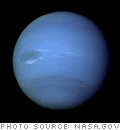Neptune

 |
Little was known about Neptune until Aug. 1989, when NASA's Voyager 2 became the first spacecraft to observe the planet. Passing about 3,000 mi (4,950 km) above Neptune's north pole, Voyager 2 made its closest approach to any planet since leaving Earth 12 years prior. The spacecraft passed about 25,000 mi (40,000 km) from Neptune's largest moon, Triton, the last solid body that Voyager 2 studied before continuing on to the outer boundary of the solar system.
Nearly 3 billion miles (4.5 billion kilometers) from the Sun, Neptune orbits the Sun once in 165 years, and therefore has made not quite a full circle around the Sun since it was discovered.1
With an equatorial diameter of 30,775 mi (49,528 km), Neptune is the smallest of our solar system's four gas giants, which also include Jupiter, Saturn, and Uranus.2 Even so, its volume could hold nearly 60 Earths. Neptune is also denser than the other gas giants and about 64% heavier than if it were composed entirely of water.
Neptune has a blue color as a result of methane in its atmosphere. Methane preferentially absorbs the longer wavelengths of sunlight (those near the red end of the spectrum). What are left to be reflected are colors at the blue end of the spectrum. The atmosphere of Neptune is mainly composed of hydrogen, with helium and traces of methane and ammonia.
Neptune is a dynamic planet even though it receives only 3% as much sunlight as Jupiter does. Voyager 2 discovered several large, dark spots that were prominent features on the planet. The largest spot was about the size of Earth and was designated the “Great Dark Spot” by its discoverers. It appeared to be an anticyclone similar to Jupiter's Great Red Spot. While Neptune's Great Dark Spot is comparable in size, relative to the planet, and at the same latitude (22°S latitude) as Jupiter's Great Red Spot, it was far more variable in size and shape than its Jovian counterpart. Bright, wispy “cirrus-type” clouds overlaid the Great Dark Spot at its southern and northeast boundaries.
At about 42°S latitude, a bright, irregularly shaped eastward-moving cloud circled much faster than did the Great Dark Spot, “scooting” around Neptune in about 16 hours. This “scooter” may have been a cloud plume rising between cloud decks.
Another spot, designated “D2,” was located far to the south of the Great Dark Spot, at 55°S latitude. It is almond-shaped, with a bright central core, and moves eastward around the planet in about 16 hours.
In 1995, images taken by the Hubble Space Telescope showed that the Great Dark Spot has vanished. The great storm center has either dissipated or is obscured by other atmospheric conditions.
The atmosphere above Neptune's clouds is hotter near the equator, cooler in the mid-latitudes, and warm again at the south pole. Temperatures in the stratosphere were measured to be 750°K (900°F), while at the 100-millibar pressure level they were measured to be 55°K (–360°F).
Long, bright clouds, reminiscent of cirrus clouds on Earth, were seen high in Neptune's atmosphere. They appear to form above most of the methane, and consequently are not blue.
At northern low latitudes (27°N), Voyager captured images of cloud streaks casting their shadows on cloud decks estimated to be about 30 to 60 mi (50 to 100 km) below. The widths of these cloud streaks range from 30 to 125 mi (50 to 200 km). Cloud streaks were also seen in the southern polar regions (71°S) where the cloud heights were about 30 mi (50 km).
Most of the winds on Neptune blow in a westward direction, which is retrograde, or opposite to the rotation of the planet.
In Jan. 2000, astronomers announced taking the best Earth-based infrared images of Neptune, captured by the W. M. Keck II telescope in Hawaii. The images revealed giant 600-mph (966-km/hr) storms born of heat generated from the planet's still-contracting core. Storm features are pulled across the face of Neptune as it whirls through its 16-hour day.







